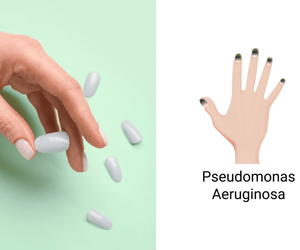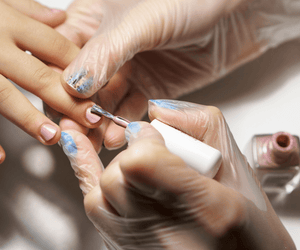When you book an acrylic nail appointment, you assume you’ll come out of it totally in love. Unfortunately, that’s not always the outcome, and you might find that your acrylics are too long and unwieldy. Even if your nails looked perfect when you first left the salon, a few weeks of grow-out can make a big difference.
If you’re not able to get back into your nail tech’s chair for reshaping, we’ve created this guide so you can learn how to trim acrylic nails at home.
Reasons to Trim Acrylic Nails
Learning to maintain and adjust your acrylic nails can be useful in a few different scenarios.
Grow-Out
Your acrylics will get longer as your natural nails grow out, and you'll end up with a visible gap between the bottom of your acrylics and the cuticles.
Usually, by the time the grow-out is noticeable, most manicurists will recommend you come in for an in-fill. During an in-fill appointment, they'll add more acrylic to the gap at the base and adjust the tips of your nails. If you're not planning to get your nails refilled, trimming them could help you feel more comfortable for an extra week or so before removing your acrylics.
Not Your Style
Maybe you just don't love how long your acrylic nails turned out. Once again, going back to the salon to have them shortened is probably your best bet, but if you're set on trimming your acrylic nails at home, that's okay too.
Tough to Handle
The idea of having long acrylic nails can be enticing and glamorous, but once applied, you may discover that they can actually be tough to deal with and that they impact your fine motor skills. A little trim could make all the difference.
Essential Tools for Trimming Acrylic Nails
You only need a couple of common nail tools and accessories to trim your acrylic nails at home. For best results, choose tools designed specifically for acrylics rather than natural nails.
- Nail polish remover
- Cotton pad or ball
- Nail file (150 grit or dual-sided 100/180 grip file) or e-file with medium or fine grip bits
- Optionally, a nail clipper (ideally one designed for acrylic nails).
Step-by-Step Guide to Trimming Acrylic Nails
Finally, here’s how to trim your acrylic nails at home, step-by-step, taking into account the different tools you may have on hand.
1. Determine Ideal Length
Before you start trimming, take a moment to consider how much shorter you'd like to make your acrylics. If you're only looking for a subtle difference, you'd be better off filing your nails down rather than trimming them.
2. Remove Nail Polish (Optional But Recommended)
If your acrylic nails have been painted with regular nail polish, consider removing it before you start trimming. On the other hand, acrylic nails made of a colorful material or painted with UV-cured gel can just be trimmed as they are.
3. Use Clippers on Angle
If you've decided you'd like to take off a lot of length, a clipper will be faster, although it does hold some risk. It's very hard to control the shape when clipping acrylics, and if you clip too aggressively, you could end up splitting the acrylic down the middle.
For best results, choose a clipper designed specifically for acrylic nails, although a regular clipper could work as well.
If using a regular clipper, don't clip straight across the free edge of your acrylics. Instead, hold the clipper so it's slightly diagonal to the nail, and carefully clip one corner of the tip. Then, do the same on the other side. Repeat the small clips from side to side until you’ve achieved your desired length.
If using a clipper designed for acrylics, you might be able to clip straight across. Clip slowly, holding the clipper at a downward angle to achieve a more rounded tip.
4. Use File or eFile
If you've already clipped your acrylics or you just need to take off a little bit of length, a file is best for the job. If you’ll be using a manual file, a side with 150 grit will work best. Carefully file along the free edge in small motions until you reach your desired length and shape. Don't forget to refine the sides as well.
If using an e-file, choose a fine or medium bit, and be careful to avoid applying too much pressure.
5. Thin Out the Tip
Acrylic nails are three-dimensional, normally with the thickest part (the apex) near the center of the nail plate. The acrylic becomes progressively thinner as it tapers down to the tip. Once you’ve shortened the nail, whether with a nail clipper or a nail file, you’ll end up with an oddly thick tip. To achieve a more comfortable and natural look, you’ll now need to thin out that tip with the help of your nail file.
Whether you’re using a manual nail file or e-file, your goal is to file the nail from above so that it achieves a new taper. To do this, hold the file on a downward angle against the top of the acrylic and carefully file down toward the tip. Repeat as needed until you achieve a nicely tapered, thin, free edge.
6. Refine the Shape
Finally, examine your acrylic nails again and make final corrections to the shape with a manual nail file. Make sure to buff away any snags or uneven spots. If needed, you can also buff the surface of the acrylics, especially if you plan to reapply nail polish. That said, make sure to wash away any acrylic powder and then dry your nails thoroughly before reapplying any nail art!
7. Give Your Nails Some TLC
It’s best practice to oil up your cuticles regularly when wearing acrylic nails, and after a trim is as good a time as any. Give your hands a little love with hand cream, and finish with a swipe of oil at the base of your nails.
Common Mistakes to Avoid
Acrylic nails are harder, thicker, and less flexible than natural nails, so you can’t trim them in the same way. The most common mistake is using a regular nail clipper and attempting to cut the acrylics straight across the tip. This can cause them to crack down the middle.
Additionally, don’t forget to thin out the tip of the acrylics. Having a thick edge isn’t just an aesthetic issue — it could also throw the nails off balance and potentially lead to the acrylics lifting or breaking.
When to Seek Professional Help
If you're planning to maintain salon acrylics for the long-term, it’s better to leave all the work to the professionals. It takes a lot of training and experience to become a nail technician, and you might not be able to achieve that neatly trimmed shape by yourself at home. Plus, if you don't like the length your manicurist gave you, they'd probably appreciate the chance to fix and refine your shape.
Additionally, if you don't have the tools necessary, like a low-grit nail file or a pair of clippers, that's another great reason to go to a salon. With proper clippers and e-files, your manicurist can shorten your acrylics quickly and flawlessly.
Your DIY Alternative
If you've learned that acrylic nails aren't for you, there are DIY alternatives that might give you the same level of joy without the hassle or expense of visiting the salon. Press-on nails offer a temporary nail extension that's easy to apply and remove at home. Today's press-ons come in all shapes, colors, and sizes, with artistic designs that are as beautiful as any nail art. You can even choose shorter nail options that'll be much easier to live with day to day.
Bottom Line
You can certainly trim your acrylic nails at home, as long as you do it carefully — small cuts are better than making one long cut across the nail, and using a nail buffer exclusively is always best. If you plan on maintaining your acrylics for the long-term, the simplest option is to get back into your nail tech’s chair.
On the other hand, if you’ve discovered that acrylic nails aren’t for you, you can also choose press-ons for easier home maintenance and the same level of glamor without the high price tag!








